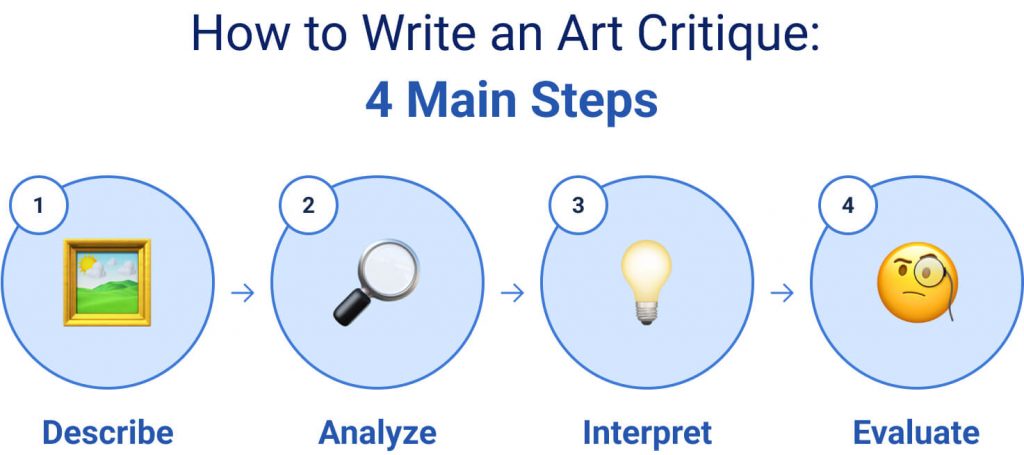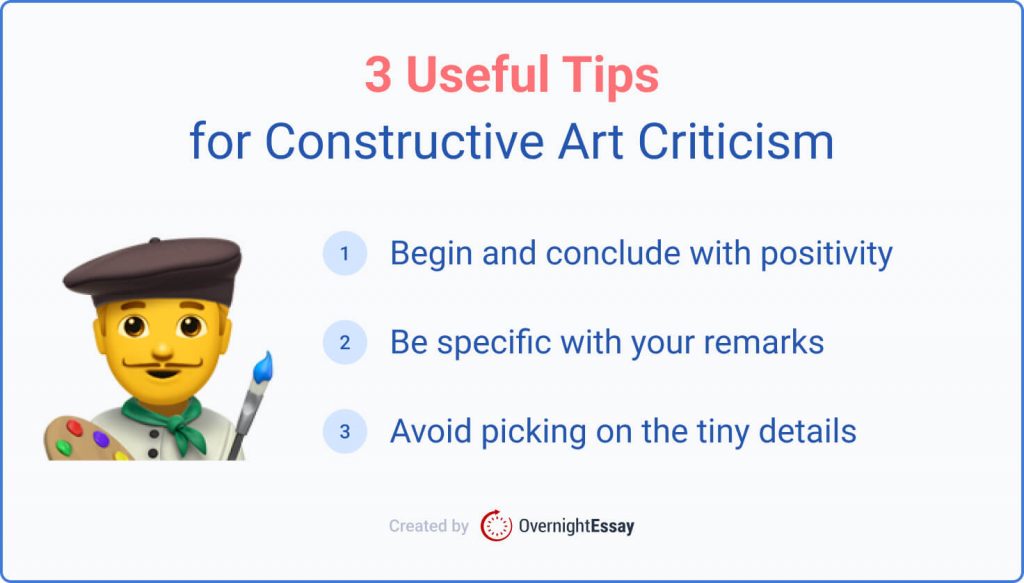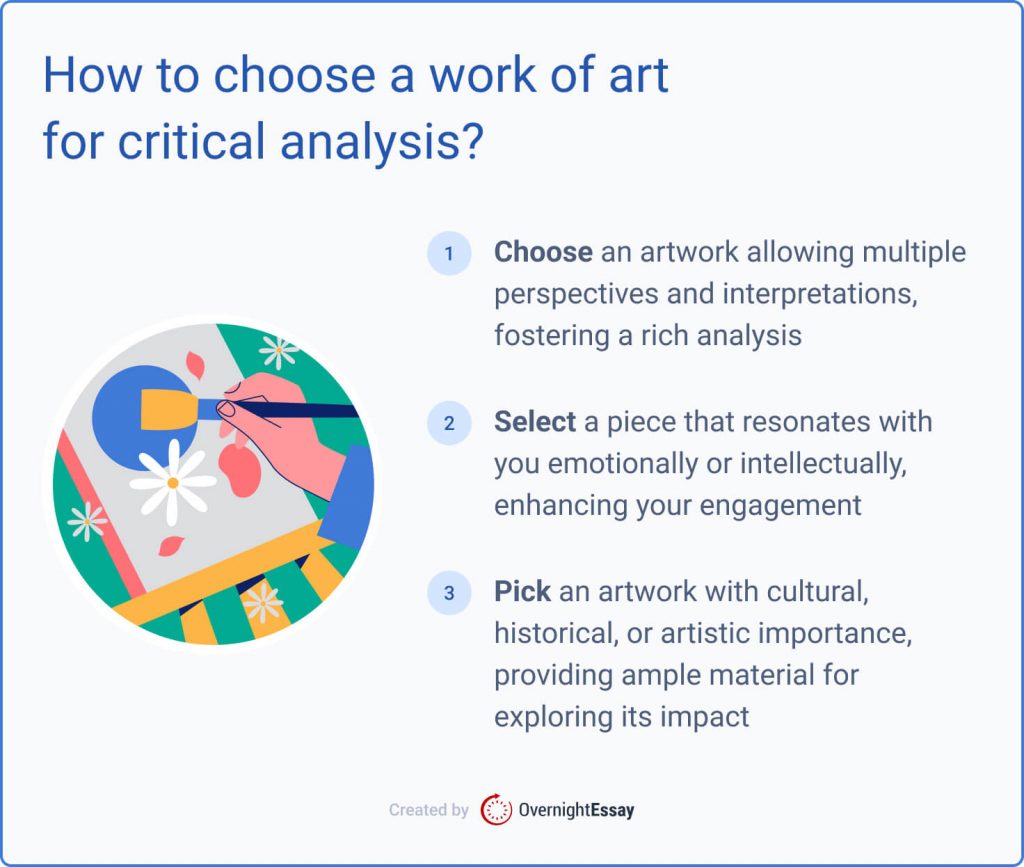Art is an integral part of the human experience, as it inspires and helps us develop a sense of beauty. It can catch you off guard during a visit to an art gallery or on a forest walk in the autumn. Even such a mundane thing as a sunset can invoke expressive feelings you can’t quite explain. And oftentimes, the emotion spectrum of a painted sunset differs from a photograph. However, writing your critique review about art can be more challenging than admiring it.
Don’t stress and fret if you get an art critique assignment and need to improve your skills. Our team has created a guide that contains everything you need to know about writing this type of essay. We will also explain its four components and provide art critique examples that can inspire your own writing.
🎭 What Is an Art Criticism Essay?
“Why do you even need to criticize art?” is a legitimate question that you might be asking. Isn’t it enough that someone spent their time and made something? What’s the point of breaking down their work?
While it is true that the word “critique” evokes negative associations, there is more to it than just pointing out an artwork’s flaws. A well put criticism allows you, your audience, and the artist themselves to see the work from a different angle.

A good critique paper provides several things:
- An outside opinion of the work. Despite the common misconception, artists love to discuss their creations and those of their peers. A critique provides valuable data for their subsequent artistic pursuits and may point towards things artists didn’t consider because of their limited scope of work.
- A better understanding of one’s skills. A well-written art critique never seeks to tear down its subject. Instead, it serves as an assessment of the person’s artistic skills. A good analysis helps them pay attention to unexplored parts of their work.
- A new perspective. An artist can grow only when they know what needs improvement. Listening to praise all the time limits their development. A critical paper can point them in a better direction without being obnoxious or judgmental.
- A more profound sense of community. An art critique helps artists develop and see themselves from the other side. It makes them more open to discussing their opinions and values. That gives them a better understanding of what motivates and guides others.
An art critique is an outside opinion of the creator’s work that helps them improve their style and techniques. A well-made art critique tells what other people think of the artist’s efforts and draws attention to issues that must be solved, which leads to better professional and personal growth. Additionally, it lets us understand the work of old masters on a deeper level, evaluating where they succeeded or failed.
🖼️ Guide: How to Write an Art Critique
When you get down to basics, criticizing a creative work is also an art form in itself. That’s why students often struggle to describe works of art, especially if it’s their first time doing so.

When working on a critique, you must include several components we’ll cover later:
- Description of the work.
- Artist’s intentions and analysis.
- Response and interpretation.
- Conclusions and evaluation.
This approach is also known as the Feldman model and is widely used in art. Let’s look at each part and its role in writing an excellent art critique.
Description of the Work
When making an art critique, examining the subject thoroughly is essential. Your first impression and initial response to the piece are critical, so take the time to absorb it. When evaluating an artwork, learn about its background (author, significance, prominent motifs, and techniques.) You can also discuss the work’s medium, brushstrokes, color scheme, or any other relevant details.
Next, address the content of the work: the scene, figures, and objects depicted on the canvas or in the sculpture. You can mention the size of the work, texture, lines, composition, and perspective. If you’re looking for excellent art to examine, check out Caravaggio’s The Calling of St. Matthew. It’s a masterpiece that combines light, shadow, expressions, and movement to tell a story in a single frame.
Artist’s Intentions & Analysis
After you’re done admiring the piece, it’s time to determine what makes it work. When going through your visual findings, try answering the reason behind their use. For example, why did the artist use a particular type of paint or composed the frame in a certain way? It helps to establish an artist’s intent behind their work.
To make a comprehensive art criticism essay, look at the larger context. Learn about the artist, what drove them to create, and the biggest influences on their work. This helps better understand why they chose to create a particular piece during a certain artistic period. For example, Carravagio made some of his best paintings as church commissions, hence the wide use of Christian symbolism in many of his works.
Response & Interpretation
Art critique essays often hyperfocus on the artist and their work, forgetting that, ultimately, spectators are the ones experiencing it. In this part of the analysis, share what feelings the painting or sculpture evokes in your mind. There are no wrong answers here, as everybody sees art from their perspective. Look past what the artist tries to depict and explain the meaning you see behind the art.
When evaluating a work of art, think about what it makes you feel (joy, anger, sadness, and so on.) Next, think about the area or figure that draws your attention. Note the artistic choices that brought the whole thing together. Addressing these things will make your analysis more comprehensive.
Conclusions & Evaluation
Remember that a criticism is largely a personal opinion based on your experience and interpretation. The conclusion section of the art criticism essay should also evaluate the effectiveness of the artist’s choices in creating the right impact on the viewers and seeing their vision through. Think about how the artwork made you feel, using personal thoughts and feelings.
Once everything is said, you have to provide a summary of the art piece. Don’t try to imagine what the person could have done with the work. Instead, evaluate what they achieved with it. When working on this part of the essay, analyze the author’s intention, whether they were successful, and whether the piece was worth evaluating.
🧐 Artwork Critique – 10 Questions to Ask
In addition to this guide, we would like to provide a set of questions that will help you with your art criticism essay. There’s no need to answer all of them in your work, but knowing about them won’t hurt. Whether you’re writing a work about one of the classical pieces or contemporary abstract art, these questions can guide you. They can help you overcome your writer’s block, provide new ideas, or ensure that you stay on the right track.
- Is the choice of colors balanced, or do they clash?
- Where is the horizon line placed, and how does it influence the work?
- How does the color scheme work to set the piece’s mood?
- Is the composition set to make the scene look three-dimensional?
- Are the elements of the art piece positioned the right way?
- What idea did the artist want to convey in the work?
- Does the author use light and shadow properly?
- How does the artist express human emotions?
- Are there any errors with the composition?
- What is the main focus of the artwork?
👩🎨 Helpful Tips for Writing Constructive Art Criticism Essay
Sometimes, it is challenging to describe some details or set the tone for a critical essay. So, we’ve picked tips to help you create the perfect analysis paper.

🎨 Artwork Critique Examples
To provide a better understanding of writing an art criticism essay, we’d like to give you a couple of examples to think about. These small samples will help you choose the proper language and paragraph structure to create a good artwork analysis. We hope you’ll find our art critique essay examples inspiring.
Raphael’s Madonna in a Chair.
Rightfully admired as one of the best painters of the High Renaissance era, Raphael showed a human side of the divine, most notably in his works related to the Madonna and baby Christ. Even the small-scale Madonna in a Chair showcases his talent despite the size of the canvas.
The title is a bit misleading, as its main focus is the Son of God. Here, he is depicted in the embrace of Mary, cradling him with both her arms. The piece heavily utilizes the U shape in the figures of the Madonna, Christ, and the praying child who’ll grow up to be John the Baptist. The latter looks at them with awe and adoration, hands clasped in prayer.
As in all his works, Raphael depicted the Mother of Christ not as a divine figure but as a mother, fearful and protective of her child. A slight off-balance to the left makes this scene more warm and intimate, with Christ’s and Madonna’s shapes radiant with an inner light. The color scheme used lighter hues for parts of the shawl, dress, and cloth the baby was wrapped in.
Raphael showed a true mastery of color, light, and shadow to capture the essence of motherhood. He deliberately dimmed the colors on the sides of the painting to make its centerpiece more vibrant and life-like.
The rounded shape of the work accentuates the effect of looking at people through an open window. This is how the painter made it feel like we have witnessed the tender moment and have been discovered, with both Madonna and Christ looking at us.
A Bar at the Folies-Bergere by Edouard Manet.
Edouard Manet is a figure well-known to the admirers of the French impressionist movement. His works gave a rare insight into Paris’s everyday and social life during the mid-1800s. One of Manet’s later works, A Bar at the Folies-Bergère, continues this pursuit and takes us to the rowdy scene of a nightclub in the historical district of the capital.
Instead of painting a vibrant scene, Manet focused on a single person working at the establishment’s bar. She’s a young woman (probably in her 20s) who stands behind the counter selling fruit and alcohol to the patrons of Folies-Bergère. Despite the atmosphere of the place, the woman looks detached from things happening around her. She’s the only person to have distinguishing features.
Manet used multiple brushstrokes for each object to make them look distorted and out of focus. The further we get from the center of the piece, the blurrier the lines become. Sometimes, they turn into haze, erasing the lines between individuals.
The use of dark and gray tones in the mirror’s reflection further emphasizes the cold feel of the place despite its intended atmosphere. In my opinion, the mirror lets the audience perceive the scene from the eyes of the woman as if we were the ones looking at the bar.
The painting beautifully depicts two things: isolation and movement. Although visitors surround her, the person in the center of the image doesn’t seem to enjoy it. Her eyes are slightly cast down, perhaps in contemplation or daydreaming. Despite her state, the world carries on.
Artwork Critique: How to Choose Masterpiece for Analysis
In this section, we’ve compiled a little guide for picking the perfect piece of art for you to analyze. Check it out:

📌 Make preliminary research to understand different art forms, styles, or movements. It’s beneficial to familiarize yourself with artists’ backgrounds and historical context.
📌 Think about the themes and concepts you want to reveal in your analysis. Do you want to explore the artwork’s symbolism, aesthetic qualities, or historical significance?
📌 Select an artwork that personally resonates with you or piques your interest. A genuine connection with the piece will make the analysis more enjoyable and insightful.
📌 Consider exploring a diverse range of art periods. Analyzing a variety of artworks will broaden your perspective and enhance your critical analysis skills.
💡 Art Criticism Essay Topic Ideas
Finally, we’d like to offer a list of topics on which you can write your following critical paper. Perhaps here you’ll find something inspiring for your next piece of work.
- The role of Christian symbolism in Caravaggio’s works.
- Van Gogh’s Starry Night and the impressionist movement.
- Claude Monet’s Poppies: a study in perspective.
- Pablo Picasso’s Les Demoiselles d’Avignon and 20th century art.
- Explore the composition of Sandro Botticelli’s Adoration of the Magi.
- Edward Hopper’s Nighthawks and social isolation.
- Evaluate the use of light and shadow in Rembrandt’s The Night’s Watch.
- How did Johannes Vermeer achieve the realistic effect in his Girl with a Pearl Earring portrait?
- Discuss the symbolism of The Creation of Adam by Michelangelo.
- What message did Hieronymus Bosch try to convey in The Garden of Earthly Delights?
- Explore the minimalist style used in Georges Seurat’s A Sunday Afternoon on the Island of La Grande Jatte.
- Comparison of the Caravaggio, Bernini, and Rembrandt Artworks.
- Describe the artistic significance of Emanuel Leutze’s Washington Crossing the Delaware.
- The use of color in J. W. Waterhouse’s The Lady of Shalott.
- Explain the use of the perspective in Claude Monet’s Woman with a Parasol.
- Which techniques were used to paint the Sistine Chapel ceiling?
- Peter Paul Rubens’ The Raising of the Cross.
- Explore the use of color in Leonardo da Vinci’s Mona Lisa.
- Which events are depicted in Delacroix’s Liberty Leading the People?
- The Persistence of Memory and the surrealist movement.
- The Swing by Jean-Honoré Fragonard.
- Analyze The Great Wave of Kanagawa and its influence on the ukiyo-e genre.
- Wanderer above the Sea of Fog and solitude.
- Explore the themes of Pieter Bruegel’s The Hunters in the Snow.
- Examine the use of color in Leighton’s Flaming June.
- How Renoir composed the scene in Bal du moulin de la Galette.
- A critical look at The Sistine Madonna.
- Gustav Klimt’s The Kiss.
Our guide will help you write a better art critique essay about ancient and contemporary masterpieces. We’re sure that it has all the answers you seek. And if you still need to come up with a topic, you can always try our essay topic generator.